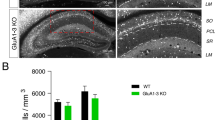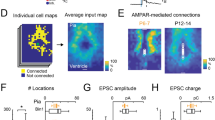Abstract
Early in postnatal development, inhibitory inputs to rat lateral superior olive (LSO) neurons change from releasing predominantly GABA to releasing predominantly glycine into the synapse. Here we show that spontaneous miniature inhibitory postsynaptic currents (mIPSCs) also change from GABAergic to glycinergic over the first two postnatal weeks. Many 'mixed' mIPSCs, resulting from co-release of glycine and GABA from the same vesicles, are seen during this transition. Immunohistochemistry showed that a large number of terminals contained both GABA and glycine at postnatal day 8 (P8). By P14, both the content of GABA in these mixed terminals and the contribution of GABA to the mixed mIPSCs had decreased. The content of glycine in terminals increased over the same period. Our results indicate that switching from GABAergic to glycinergic inputs to the LSO may occur at the level of a single presynaptic terminal. This demonstrates a new form of developmental plasticity at the level of a single central synapse.
This is a preview of subscription content, access via your institution
Access options
Subscribe to this journal
Receive 12 print issues and online access
$209.00 per year
only $17.42 per issue
Buy this article
- Purchase on Springer Link
- Instant access to full article PDF
Prices may be subject to local taxes which are calculated during checkout






Similar content being viewed by others
References
Ornung, G. et al. Qualitative and quantitative analysis of glycine- and GABA-immunoreactive nerve terminals on motoneuron cell bodies in the cat spinal cord: a postembedding electron microscopic study. J. Comp. Neurol. 365, 413–426 (1996).
Yang, H.W., Min, M.Y., Appenteng, K. & Batten, T.F. Glycine-immunoreactive terminals in the rat trigeminal motor nucleus: light- and electron-microscopic analysis of their relationships with motoneurones and with GABA-immunoreactive terminals. Brain Res. 749, 301–319 (1997).
Levi, S., Chesnoy-Marchais, D., Sieghart, W. & Triller, A. Synaptic control of glycine and GABAA receptors and gephyrin expression in cultured motoneurons. J. Neurosci. 19, 7434–7449 (1999).
Kneussel, M. & Betz, H. Receptors, gephyrin and gephyrin-associated proteins: novel insights into the assembly of inhibitory postsynaptic membrane specializations. J. Physiol. 525, 1–9 (2000).
O'Brien, J.A. & Berger, A.J. Cotransmission of GABA and glycine to brain stem motoneurons. J. Neurophysiol. 82, 1638–1641 (1999).
Jonas, P., Bischofberger, J. & Sandkuhler, J. Co-release of two fast neurotransmitters at a central synapse. Science 281, 419–424 (1998).
Russier, M., Kopysova, I.L., Ankri, N., Ferrand, N. & Debanne, D. GABA and glycine co-release optimizes functional inhibition in rat brainstem motoneurons in vitro. J. Physiol. 541,123–137 (2002).
Kotak, V.C., Korada, S., Schwartz, I.R. & Sanes, D.H. A developmental shift from GABAergic to glycinergic transmission in the central auditory system. J. Neurosci. 18, 4646–4655 (1998).
Smith, A.J., Owens, S. & Forsythe, I.D. Characterization of inhibitory and excitatory postsynaptic currents of the rat medial superior olive. J. Physiol. 529, 681–698 (2000).
Sanes, D.H. & Friauf, E. Development and influence of inhibition in the lateral superior olivary nucleus. Hear. Res. 147, 46–58 (2000).
Korada, S. & Schwartz, I.R. Development of GABA, glycine, and their receptors in the auditory brainstem of gerbil: a light and electron microscopic study. J. Comp. Neurol. 409, 664–681 (1999).
del Castillo, J. & Katz, B. Quantal components of end-plate potential. J. Physiol. 124, 560–573 (1954).
Walmsley, B., Alvarez, F.J. & Fyffe, R.E. Diversity of structure and function at mammalian central synapses. Trends Neurosci. 21, 81–88 (1998).
Akaike, N. & Moorhouse, A.J. Techniques: applications of the nerve-bouton preparation in neuropharmacology. Trends Pharmacol. Sci. 24, 44–47 (2003).
Dumoulin, A., Triller, A. & Dieudonne, S. IPSC kinetics at identified GABAergic and mixed GABAergic and glycinergic synapses onto cerebellar Golgi cells. J. Neurosci. 21, 6045–6057 (2001).
Keller, A.F., Coull, J.A., Chery, N., Poisbeau, P. & De Koninck, Y. Region-specific developmental specialization of GABA-glycine cosynapses in laminas I-II of the rat spinal dorsal horn. J. Neurosci. 21, 7871–7880 (2001).
Friauf, E, Hammerschmidt, B. & Kirsch, J. Development of adult-type inhibitory glycine receptors in the central auditory system of rats. J. Comp. Neurol. 385, 117–134 (1997).
Otis, T.S., De Koninck, Y. & Mody, I. Lasting potentiation of inhibition is associated with an increased number of gamma-aminobutyric acid type A receptors activated during miniature inhibitory postsynaptic currents. Proc. Natl. Acad. Sci. USA 91, 7698–7702 (1994).
Sanes, D.H. & Siverls, V. Development and specificity of inhibitory terminal arborizations in the central nervous system. J. Neurobiol. 22, 837–854 (1991).
Kim, G. & Kandler, K. Elimination and strengthening of glycinergic/GABAergic connections during tonotopic map formation. Nat. Neurosci. 6, 282–290 (2003).
Gasnier, B. The loading of neurotransmitters into synaptic vesicles. Biochimie 82, 327–337 (2000).
Schotzinger, R.J. & Landis, S.C. Cholinergic phenotype developed by noradrenergic sympathetic neurons after innervation of a novel cholinergic target in vivo. Nature 335, 637–639 (1988).
Habecker, B.A., Tresser, S.J., Rao, M.S. & Landis, S.C. Production of sweat gland cholinergic differentiation factor depends on innervation. Dev. Biol. 167, 307–316 (1995).
Rietzel, H.J. & Friauf, E. Neuron types in the rat lateral superior olive and developmental changes in the complexity of their dendritic arbors. J. Comp. Neurol. 390, 20–40 (1998).
Takahashi, T., Momiyama, A., Hirai, K., Hishinuma, F. & Akagi, H. Functional correlation of fetal and adult forms of glycine receptors with developmental changes in inhibitory synaptic receptor channels. Neuron 9, 1155–1161 (1992).
Kakazu, Y., Akaike, N., Komiyama, S. & Nabekura, J. Regulation of intracellular chloride by cotransporters in developing lateral superior olive neurons. J. Neurosci. 19, 2843–2851 (1999).
Kandler, K. & Friauf E. Development of glycinergic and glutamatergic synaptic transmission in the auditory brainstem of perinatal rats. J. Neurosci. 15, 6890–6904 (1995).
Balakrishnan, V. et al. Expression and function of chloride transporters during development of inhibitory neurotransmission in the auditory brainstem. J. Neurosci. 23, 4134–4145 (2003).
Kullmann, P.H., Ene, F.A. & Kandler, K. Glycinergic and GABAergic calcium responses in the developing lateral superior olive. Eur. J. Neurosci. 15, 1093–1104 (2002).
Gao, B.X. & van den Pol, A.N. GABA, not glutamate, a primary transmitter driving action potentials in developing hypothalamic neurons. J. Neurophysiol. 85, 425–434 (2001).
Ganguly, K., Schinder, A.F., Wong, S.T. & Poo, M. GABA itself promotes the developmental switch of neuronal GABAergic responses from excitation to inhibition. Cell 105, 521–532 (2001).
Lauder, J.M., Liu, J., Devaud, L. & Morrow, A.L. GABA as a trophic factor for developing monoamine neurons. Perspect. Dev. Neurobiol. 5, 247–259 (1998).
Kirsch, J. & Betz, H. Glycine-receptor activation is required for receptor clustering in spinal neurons. Nature 392, 717–720 (1998).
Kotak, V.C., DiMattina, C. & Sanes, D.H. GABAB and Trk receptor signaling mediates long-lasting inhibitory synaptic depression. J. Neurophysiol. 86, 536–540 (2001).
Chang, E.H., Kotak, V.C. & Sanes, D.H. Long-term depression of synaptic inhibition is expressed postsynaptically in the developing auditory system. J. Neurophysiol. 90, 1479–1788 (2003).
Kakazu, H., Uchida, S., Nakagawa, T., Akaike, N. & Nabekura, J. Reversibility and cation selectivity of K+-Cl− cotransport in rat CNS Neurons. J. Neurophysiol. 84, 281–288 (2000).
Nabekura J., Omura T. & Akaike N. Alpha2 adrenoceptor potentiates glycine receptor-mediated taurine response through protein kinase A in rat substantia nigra neurons. J. Neurophysiol. 76, 2447–2454 (1996).
Matsubara, A., Laake, J.H., Davanger, S., Usami, S. & Ottersen, O.P. Organization of AMPA receptor subunits at a glutamate synapse: a quantitative immunogold analysis of hair cell synapses in the rat organ of Corti. J. Neurosci. 16, 4457–4467 (1996).
Ottersen, O.P., Zhang, N. & Walberg, F. Metabolic compartmentation of glutamate and glutamine morphological evidence obtained by quantitative immunocytochemistry in rat cerebellum. Neuroscience 46, 519–534 (1992).
Kaufman, D.L., McGinnis, J.F., Krieger, N.R. & Tobin, A.J. Brain glutamate decarboxylase cloned in lambda gt-11: fusion protein produces gamma-aminobutyric acid. Science 232, 1138–1140 (1986).
Acknowledgements
We thank A. Moorhouse for discussion and editing of the manuscript, and N. Akaike for technical advice. We also thank O.P. Otterson, I.J. Kopin, W.H. Oertel, D.E. Schmechel and M.L. Tappaz for help obtaining antibodies. This work was supported by research grants from the Ministry of Education, Culture, Sports, Science and Technology, Japan (15016082, 15650076 and 15390065 to J.N).
Author information
Authors and Affiliations
Corresponding author
Ethics declarations
Competing interests
The authors declare no competing financial interests.
Supplementary information
Supplementary Fig. 1
Sensitivity of antibody to GABA and glycine. Test sections were incubated in the same drops of glycine and GABA antibodies together with LSO sections. Note that the glycine conjugates are stained selectively positive for the 10 nm gold particles while the GABA conjugates are immunolabeled for 20 nm gold particles. None: without addition of any amino acid. (JPG 14 kb)
Supplementary Fig. 2
Histogram showing the particle densities representing the sum of GABA and glycine in the presynaptic terminals in the P14 rat LSO. Note that the histogram displays two peaks, less than 5 and more than 10. Thus, particle densities less than 5 (particles/μm2) of GABA and glycine were considered to show background level labeling. Terminals > 5 (particles/μm2) were employed for analysis as inhibitory terminals. (JPG 27 kb)
Rights and permissions
About this article
Cite this article
Nabekura, J., Katsurabayashi, S., Kakazu, Y. et al. Developmental switch from GABA to glycine release in single central synaptic terminals. Nat Neurosci 7, 17–23 (2004). https://doi.org/10.1038/nn1170
Received:
Accepted:
Published:
Issue Date:
DOI: https://doi.org/10.1038/nn1170
This article is cited by
-
Development of γ-aminobutyric acid-, glycine-, and glutamate-immunopositive boutons on the rat genioglossal motoneurons
Brain Structure and Function (2021)
-
Long-term potentiation of glycinergic synapses by semi-natural stimulation patterns during tonotopic map refinement
Scientific Reports (2020)
-
Deficiency of the palmitoyl acyltransferase ZDHHC7 impacts brain and behavior of mice in a sex-specific manner
Brain Structure and Function (2019)
-
Distribution of excitatory and inhibitory axon terminals on the rat hypoglossal motoneurons
Brain Structure and Function (2019)
-
Expression of functional inhibitory neurotransmitter transporters GlyT1, GAT-1, and GAT-3 by astrocytes of inferior colliculus and hippocampus
Molecular Brain (2018)



